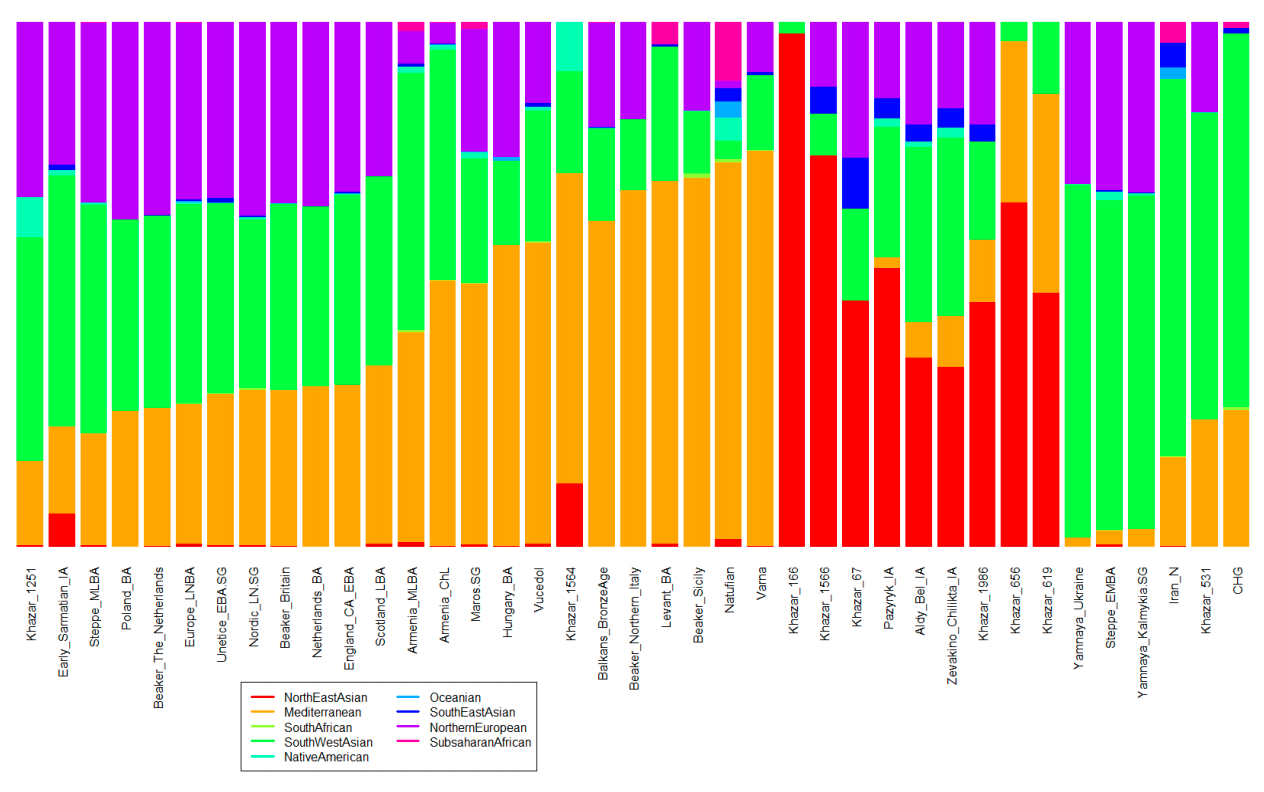real expert
Regular Member
- Messages
- 795
- Reaction score
- 455
- Points
- 63
Genome-wide analysis of 9 Khazars.
Interesting to note, there is NO significant genetic affinity with Khazars and Asheknazi Jews.
Hopefully this paper will help to put the crazy Khazar theory to bed.
Over millennia, steppe nomadic tribes raided and sometimes overran settled Eurasian civilizations. Most polities formed by steppe nomads were ephemeral, making it difficult to ascertain their genetic roots or what present-day populations, if any, have descended from them.Exceptionally, the Khazar Khaganate controlled the trade artery between the Black and Caspian Seas in VIII-IX centuries, acting as one of the major conduits between East and West. However, the genetic identity of the ruling elite within the polyglot and polyethnic Khaganate has been a much-debated mystery; a controversial hypothesis posits that post-conversion to Judaism the Khazars gave rise to modern Ashkenazim. We analyzed whole-genome sequences of eight men and one woman buried within the distinctive kurgans of the Khazar upper (warrior) class. After comparing them with reference panels of present-day Eurasian and Iron Age populations, we found that the Khazar political organization relied on a polyethnic elite. It was predominantly descended from Central Asian tribes but incorporated genetic admixture from populations conquered by Khazars. Thus, the Khazar ruling class was likely relatively small and able to maintain a genetic identity distinct from their subjugated populations over the course of centuries. Yet, men of mixed ancestry could also rise into the warrior class, possibly providing troop numbers necessary to maintain control of their large territory. However, when the Khaganate collapsed it left few persistent genetic traces in Europe.Our data confirm the Turkic roots of the Khazars, but also highlight their ethnic diversity and some integration of conquered populations.
According to a previous survey of Khazar burials, sixty-five percent of male kurgans were occupied by Mongoloids, and thirty-five by Caucasoids[18].Both Caucasoid and Mongoloid men were buried in kurgans with full honors (Figure2),suggesting that they had a privileged status within the Khazar society. If we consider men buried with Caucasoid admixture to be ethnically alien to the Khazars (or born to a mixed-race family),there was some possibility of social mobility for newcomers,regardless of their ethnic origin. It is extremely interesting that the overwhelming majority of women (more than 90%) buried in mounds with trenches are Mongoloids [18].Perhaps the Mongoloid women, being closer genetically related to the Khazars, belonged to a more privileged part of society and were more desirable as brides. This is further supported by the observation that none of the males in our sample had purely European or Middle Eastern ancestry. Even the four morphologically or genetically Caucasoid Khazars (samples #656, #533, #1251, and #1564) had some mixture of Asiatic and European nuclear DNA. This suggests that Khazar or other Asiatic ancestry may have been a major social asset in this society.
Interesting to note, there is NO significant genetic affinity with Khazars and Asheknazi Jews.
Genetic data allow us to conclusively answer the question of whether Judaized Khazars may have migrated to Eastern Europe to give rise to the present-day Ashkenazim, as proposed by the Khazarian Hypothesis. This scenario seems highly doubtful in the face of genomic data based on four lines of evidence. First, no significant Ashkenazi genetic affinity was detected in any of the sequenced individuals (Figure2B).Second, all of the studied Khazars, even those with significant Caucasian ancestry, had significant Asiatic nuclear genetic contributions, which are missing from present-day Jewish populations[11].Third, while local women were recruited into Ashkenazi communities,none of the identified mitochondrial haplotypes are present in present-day Ashkenazi Jews [37, 38].Finally, the European genetic components of the Khazars derive from the Caucasus tribes that were under control of the Khaganate, ratherthan from more distant Levantine populations more closely related to Ashkenazi and Sephardic Jews (Figure2).While Jews lived in the territory of the Khazar Khaganate along with Christians, Muslims, and pagans [1],it seems unlikely that they formed its ruling classes, which were dominated by steppe nomads from the East, and thus the Khazars could not have been the progenitors of the Ashkenazim.
Hopefully this paper will help to put the crazy Khazar theory to bed.


